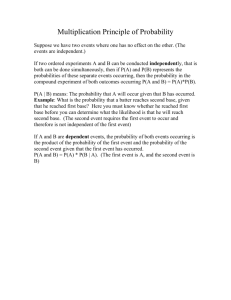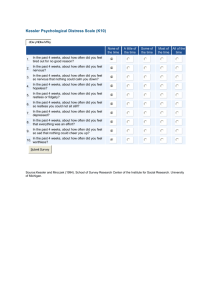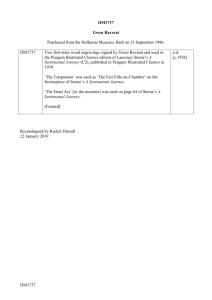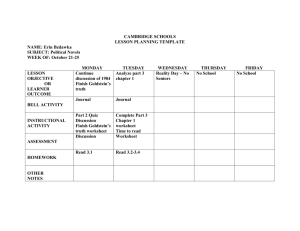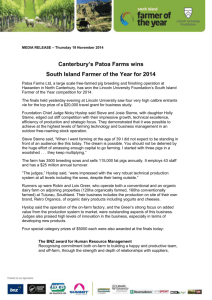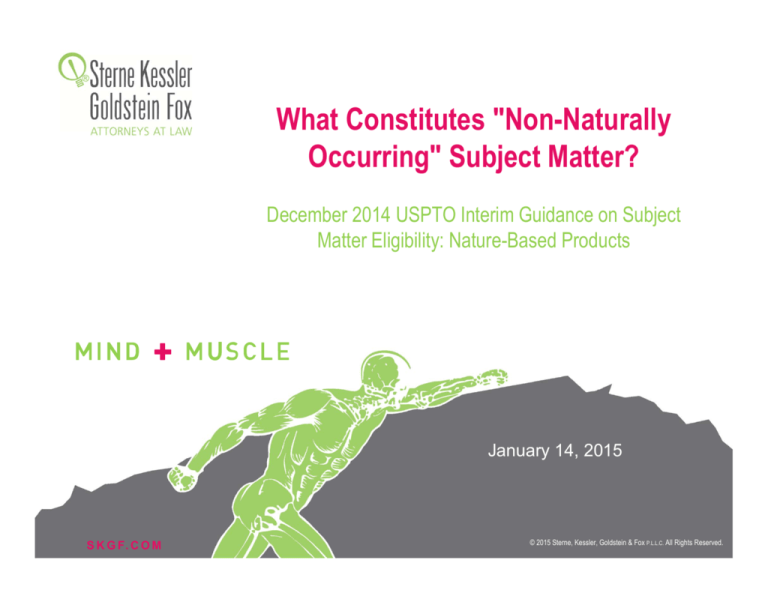
What Constitutes "Non-Naturally
Occurring" Subject Matter?
December 2014 USPTO Interim Guidance on Subject
Matter Eligibility: Nature-Based Products
January 14, 2015
S K G F. C O M
© 2015 Sterne, Kessler, Goldstein & Fox P.L.L.C. All Rights Reserved.
Three-part webinar series on subject
matter eligibility in ex parte examination
2014 Interim Guidance on Patent Subject Matter Eligibility
79 Fed. Reg. 74,618 (Dec. 16, 2014)
http://www.uspto.gov/patents/law/exam/interim_guidance_subject_matter_eligibility.jsp
New Nature Based Product Examples
http://www.uspto.gov/patents/law/exam/mdc_examples_nature-based_products.pdf
Sterne Kessler webinar schedule of :
•
What Constitutes "Non-Naturally Occurring" Subject Matter?
January 14, 2015, 2:00 - 3:00 pm EST
•
Effects on Software Patents
January 16, 2015, 2:00 - 3:00 pm EST
•
What is Left for Diagnostics?
January 22, 2015, 2:00 - 3:00 pm EST
2
S K G F. C O M
© 2015 Sterne, Kessler, Goldstein & Fox P.L.L.C. All Rights Reserved.
Nature-based products
Nature-based products
• is a term used in the Guidance (and herein) merely to refer to the types of products
that are examined to identify product of nature exceptions to patentability;
• include both patent eligible and ineligible products; and
• include both naturally occurring products and man-made products.
Nature-based products discussed in the Examples include:
•
•
•
•
•
•
•
3
Gunpowder
Beverage composition
Bacterium
Mixture of bacteria
Human antibody
Isolated polypeptide/nucleic acid
Man-made human pacemaker cell
S K G F. C O M
© 2015 Sterne, Kessler, Goldstein & Fox P.L.L.C. All Rights Reserved.
New Guidance maintains two-part analysis for
judicial exception to patentability …
Step 2A: Does the nature-based product
limitation
exhibit
markedly
different
characteristics from its naturally occurring
counterpart?
Yes → claim is deemed eligible because
it is not directed to a product of nature
exception (claims reciting a law of nature
or abstract idea need further analysis).
No → claim needs to be further analyzed
in Step 2B because it is directed to a
product of nature exception
4
S K G F. C O M
© 2015 Sterne, Kessler, Goldstein & Fox P.L.L.C. All Rights Reserved.
New Guidance maintains two-part analysis for
judicial exception to patentability …
Step 2B: Considering the claim as a
whole, is any element, or combination of
elements, in the claim is sufficient to
ensure that the claim amounts to
significantly more than the judicial
exception?
Yes → claim is eligible
No → claim is ineligible
5
S K G F. C O M
© 2015 Sterne, Kessler, Goldstein & Fox P.L.L.C. All Rights Reserved.
…with significant differences
1. Method of use claims that recite, but do not focus on
the nature-based product limitation are generally
deemed eligible without the Step 2A or Step 2B
analysis.
2. A claim that recites a nature-based product but, when
viewed as a whole, clearly does not seek to tie up a
product of nature such that others cannot practice it,
is deemed eligible without the Step 2A or 2B analysis.
3. If the nature-based product limitation is found to
exhibit markedly different characteristics from its
naturally occurring counterpart, the claim is deemed
eligible without the Step 2B analysis.
4. Markedly different characteristics can be shown
based on differences in function, and/or properties in
addition to differences in structure.
6
S K G F. C O M
© 2015 Sterne, Kessler, Goldstein & Fox P.L.L.C. All Rights Reserved.
Process claims reciting a product of
nature are generally deemed eligible
A process claims reciting a nature based product, but not other possible exception to
patentability, are generally deemed patent eligible and are not subjected to the markedly
different analysis,
A method of treating breast or colon cancer, comprising: administering an effective amount
of amazonic acid to a patient suffering from breast or colon cancer.
except in the limited situation where a process claim is drafted in such a way that there is no
difference in substance from a product claim:
A method of providing an apple.
Process claims reciting a nature based product and a possible law of nature or abstract idea will
be examined for eligibility under the Guidelines.
Pursue method of use claims with broad nature-based product scope if the corresponding
composition claim is ineligible.
7
S K G F. C O M
© 2015 Sterne, Kessler, Goldstein & Fox P.L.L.C. All Rights Reserved.
…with significant differences (cont.)
1. Method of use claims that recite, but do not focus on
the nature-based product limitation are generally
deemed eligible without the Step 2A or Step 2B
analysis.
2. A claim that recites a nature-based product but, when
viewed as a whole, clearly does not seek to tie up a
product of nature such that others cannot practice it,
is deemed eligible without the Step 2A or 2B analysis.
3. If the nature-based product limitation is found to
exhibit markedly different characteristics from its
naturally occurring counterpart, the claim is deemed
eligible without the Step 2B analysis.
4. Markedly different characteristics can be shown
based on differences in function, and/or properties in
addition to differences in structure.
8
S K G F. C O M
© 2015 Sterne, Kessler, Goldstein & Fox P.L.L.C. All Rights Reserved.
Streamlined analysis for product claims that
clearly do not seek to tie up a product-of-nature
Claim:
A fountain-style firework comprising: (a) a sparking composition, (b) calcium chloride, (c) the
gunpowder of claim 1, (d) a cardboard body having a first compartment containing the
sparking composition and the calcium chloride and a second compartment containing the
gunpowder, and (e) a plastic ignition fuse having one end extending into the second
compartment and the other end extending out of the cardboard body.
Analysis:
• claim recites two nature-based products;
• claim as a whole indicates that the claim is focused on the assembly of components that
together form the firework, not the nature-based products;
• not necessary to apply the markedly different characteristics analysis in order to
conclude that the claim is not directed to an exception → ELIGIBLE
9
S K G F. C O M
© 2015 Sterne, Kessler, Goldstein & Fox P.L.L.C. All Rights Reserved.
…with significant differences (cont.)
1. Method of use claims that recite, but do not focus on
the nature-based product limitation are generally
deemed eligible without the Step 2A or Step 2B
analysis.
2. A claim that recites a nature-based product but, when
viewed as a whole, clearly does not seek to tie up a
product of nature such that others cannot practice it,
is deemed eligible without the Step 2A or 2B analysis.
3. If the nature-based product limitation is found to
exhibit markedly different characteristics from its
naturally occurring counterpart, the claim is deemed
eligible without the Step 2B analysis.
4. Markedly different characteristics can be shown
based on differences in function, and/or properties in
addition to differences in structure.
10
S K G F. C O M
© 2015 Sterne, Kessler, Goldstein & Fox P.L.L.C. All Rights Reserved.
New Nature Based Product
Examples
http://www.uspto.gov/patents/law/exam/mdc_examples_nature-based_products.pdf
Facts:
•
•
claimed combination is explosive
three claimed substances are not explosive
Claim:
1. Gunpowder comprising: an intimate finely-ground mixture of 75% potassium nitrate, 15% charcoal
and 10% sulfur.
Analysis:
• claim recites combination of 3 nature-based products;
• no natural counterpart to combination, so the combination is compared to the individual components
as they occur in nature;
• explosive property of the claimed combination is markedly different from the non-explosive properties
of the substances by themselves in nature;
• claimed combination has markedly different characteristics →claim is not directed to a product of
nature exception → ELIGIBLE
USPTO’s Nature Based Product Examples, while not legally binding, are useful for formulating
arguments against rejections under 35 U.S.C. § 101.
11
S K G F. C O M
© 2015 Sterne, Kessler, Goldstein & Fox P.L.L.C. All Rights Reserved.
Markedly different
characteristics
Ex.
12
Nature based product
Naturally occurring
counterpart
Markedly different characteristics
1
gunpowder
individual components
explosive property
2
Pomelo juice with
preservative
Pomelo juice
slower spoiling
3
5-methyl amazonic acid
amazonic acid
chemical structure and new pharmacological
activity
3
deoxyamazonic acid
amazonic acid
chemical structure
3
controlled release
amazonic acid core
with protective natural
polymer layer
amazonic acid
structure and increased bioavailability
3
stable aqueous
amazonic acid
composition
amazonic acid
solubility (amazonic acid is insoluble in water)
4
antibiotic L in
tetrahedral crystal form
antibiotic L in
hexagonal-pyramidal
crystal form
different crystalline form that may result in
different functional properties (e.g., powder flow
behavior)
S K G F. C O M
© 2015 Sterne, Kessler, Goldstein & Fox P.L.L.C. All Rights Reserved.
Markedly different
characteristics (cont.)
Ex.
Nature based product
Naturally occurring
counterpart
Markedly different characteristics
4
antibiotic L produced
by yeast
antibiotic L
structure (glycosylation), immunogenicity, and in
vivo half-life
5
genetically engineered
bacteria
naturally occurring
bacteria
structure (genotype) and function (phenotype)
6
mixture of two bacteria
naturally occurring
individual bacteria
biological function - ability to infect new host
neither bacteria alone can infect
10
mixture of two bacteria
and milk
naturally occurring
individual bacteria and
milk
biological function - ability to ferment yoghurt with
lower fat content than either bacteria can produce
alone
13
S K G F. C O M
© 2015 Sterne, Kessler, Goldstein & Fox P.L.L.C. All Rights Reserved.
No markedly different
characteristics
Ex.
14
Nature based product
Naturally occurring counterpart
3
purified amazonic acid
amazonic acid
7
isolated nucleic acid comprising SEQ ID NO: 1
natural gene comprising SEQ ID NO: 1
8
antibody to protein S
murine antibodies to protein S
9
isolated man-made human pacemaker cell
human pacemaker cell
10
kit comprising two bacteria
individual bacteria
S K G F. C O M
© 2015 Sterne, Kessler, Goldstein & Fox P.L.L.C. All Rights Reserved.
Marked difference in properties –
slower spoiling
Facts:
• the naturally occurring pomelo tree’s fruit is often eaten raw or juiced;
• naturally occurring pomelo juice spoils in a few days even when refrigerated, due to the
growth of bacteria that are naturally present in the juice;
• suitable preservatives are known, and include naturally occurring preservatives and nonnaturally occurring preservatives
Claim:
A beverage composition comprising pomelo juice and an effective amount of an added
preservative.
Analysis:
• the slower spoiling property of the claimed combination is markedly different from
properties of the juice by itself in nature → ELIGIBLE
15
S K G F. C O M
© 2015 Sterne, Kessler, Goldstein & Fox P.L.L.C. All Rights Reserved.
Marked difference in properties –
biological activity
Facts:
•
•
•
•
Rhizobiums are naturally occurring bacteria that infect leguminous plants such as clover,
alfalfa, beans and soy;
Each species of bacteria will only infect certain types of plants;
Rhizobium species were assumed mutually inhibitive, because prior art combinations of
different bacterial species produced an inhibitory effect on each other when mixed;
Applicant discovered that particular strains of each Rhizobium species do not exert a
mutually inhibitive effect on each other, and that these strains can be used in mixed
cultures;
Claim:
An inoculant for leguminous plants comprising a plurality of selected mutually noninhibitive strains of different species of bacteria of the genus Rhizobium, said strains
being unaffected by each other in respect to their ability to fix nitrogen in the leguminous
plant for which they are specific.
Analysis:
• no indication that the mixture of bacteria according to Claim 1 has any characteristics
(structural, functional, or otherwise) that are different from the naturally occurring
bacteria → moves to Step 2B (INELIGIBLE under Funk Brothers)
16
S K G F. C O M
© 2015 Sterne, Kessler, Goldstein & Fox P.L.L.C. All Rights Reserved.
Marked difference in properties –
biological activity (cont.)
Facts:
• Applicant has also discovered that certain Rhizobium species, when mixed together,
exhibit biological properties that are different than in nature;
• For example, in nature or by itself, R. californiana will only infect lupine, but when mixed
with R. phaseoli, R. californiana will infect both lupine and wild indigo;
• R. californiana and R. phaseoli are not known to occur together in nature
Claim:
An inoculant for leguminous plants comprising a mixture of Rhizobium californiana and
Rhizobium phaseoli.
Analysis:
• when part of the mixture according to Claim 2, R. californiana infects wild indigo, a new
species of plant, but R. phaseoli continues to only infect garden beans;
• when part of the mixture of Claim 2, R. californiana has a different characteristic
(biological function) that rises to the level of a marked difference → ELIGIBLE
The Examples note that unless the examiner can show that this particular mixture of
bacteria exists in nature, this mere possibility does not bar the eligibility of this claim.
17
S K G F. C O M
© 2015 Sterne, Kessler, Goldstein & Fox P.L.L.C. All Rights Reserved.
Isolated Compounds
Facts:
• The leaves of the naturally occurring Amazonian cherry tree contain a chemical that is
useful in treating breast and colon cancers. Applicant has purified the cancer-fighting
chemical from the leaves and has named it amazonic acid. The purified amazonic acid is
structurally and functionally identical to the amazonic acid in the leaves.
• Applicant has created two derivatives: 5-methyl amazonic acid and deoxyamazonic acid.
5-methyl amazonic acid is functionally different because it stimulates the growth of hair
in addition to treating cancer. Applicant has not identified any functional difference
between deoxyamazonic acid and amazonic acid.
• Amazonic acid is absorbed through the lining of the human stomach and is rapidly
metabolized by the body. It is also insoluble in water.
Claims:
1. Purified amazonic acid.
•
2. Purified 5-methyl amazonic acid. •
3. Deoxyamazonic acid.
18
•
Moves to Step 2B - no marked difference
(INELIGIBLE as it only recites the product)
ELIGIBLE - markedly different structure and
function
ELIGIBLE - markedly different structure
S K G F. C O M
© 2015 Sterne, Kessler, Goldstein & Fox P.L.L.C. All Rights Reserved.
Isolated Compounds (cont.)
Claim:
4. A pharmaceutical composition comprising: a core comprising amazonic acid; and alayer
of natural polymeric material enveloping the core.
Analysis:
• the composition of Claim 4 is structurally different from the naturally occurring
substances, and this structural difference results in different functional characteristics in
vivo (e.g., amazonic acid is not released until the composition reaches the colon, due to
the relative indigestibility of the natural polymeric material, thus increasing the
bioavailability of the amazonic acid) → ELIGIBLE
Claim:
5. A stable aqueous composition comprising: amazonic acid; and a solubilizing agent.
Analysis:
• changed property (i.e., solubility) between amazonic acid as a part of the claimed stable
aqueous composition of Claim 5 and amazonic acid in nature is a marked difference →
ELIGIBLE
19
S K G F. C O M
© 2015 Sterne, Kessler, Goldstein & Fox P.L.L.C. All Rights Reserved.
Genetically modified organism
Facts:
• Naturally occurring Pseudomonas bacteria containing one stable energy-generating
plasmid and capable of degrading a single type of hydrocarbon are known. There are no
known Pseudomonas bacteria in nature that contain more than one stable energy
generating plasmid.
Claim:
A bacterium from the genus Pseudomonas containing therein at least two stable
energy-generating plasmids, each of said plasmids providing a separate hydrocarbon
degradative pathway.
Analysis:
• under Chakrabarty, the difference in phenotype and genotype between the claimed and
naturally occurring bacteria rises to the level of marked difference → ELIGIBLE
20
S K G F. C O M
© 2015 Sterne, Kessler, Goldstein & Fox P.L.L.C. All Rights Reserved.
Polynucleotides/ Polypeptides
Facts:
• Protein W is naturally encoded by Virginia nightshade Gene W, which has the nucleic
acid sequence disclosed as SEQ ID NO:1;
• specification discloses substitution modifications of Gene W, some of which are silent;
but may affect transcription rate and splicing;
• no substitution modifications of Gene W are known to occur in nature.
Claims:
1. Isolated nucleic acid comprising SEQ ID NO: 1.
2. Isolated nucleic acid comprising a sequence that has at least 90% identity to SEQ ID
NO: 1 and contains at least one substitution modification relative to SEQ ID NO: 1.
Analysis:
• Under Myriad, this isolated but otherwise unchanged nucleic acid of Claim 1 is
INELIGIBLE;
• the structural differences between the nucleic acids of Claim 2 and their natural
counterparts are markedly different → ELIGIBLE
Later discovered natural variant, for example the homologue of a related species may
render Claim 2 ineligible. Claim may lack written description.
21
S K G F. C O M
© 2015 Sterne, Kessler, Goldstein & Fox P.L.L.C. All Rights Reserved.
Polynucleotides (cont.)
Facts:
• Protein W is naturally encoded by Virginia nightshade Gene W, which has the nucleic
acid sequence disclosed as SEQ ID NO:1;
• specification discloses substitution modifications of Gene W, some of which are silent;
but may affect transcription rate and splicing;
• no substitution modifications of Gene W are known to occur in nature.
Claims:
3. Isolated nucleic acid comprising SEQ ID NO: 1 and further comprising a fluorescent label
attached to the nucleic acid.
4. A vector comprising the nucleic acid comprising SEQ ID NO: 1 and a heterologous
nucleic acid sequence.
Analysis:
• the structural and functional differences between the nucleic acids of Claims 3 and 4
and their natural counterparts are markedly different → ELIGIBLE
22
S K G F. C O M
© 2015 Sterne, Kessler, Goldstein & Fox P.L.L.C. All Rights Reserved.
Antibodies
Facts:
• The specification describes the discovery of naturally occurring antibodies to Protein S,
an antigen of the newly discovered Staphylococcus texana bacteria, in mice and wild
coyotes.
• No human antibodies to Protein S are naturally occurring.
• It is known that murine antibodies have different constant domains than human and
coyote antibodies, and that murine antibodies may cause allergic reactions when
administered to humans or coyotes.
Claims:
1. An antibody to Protein S.
2. An antibody to Protein S, wherein the antibody is a human antibody.
Analysis:
• Claim 1 encompasses naturally occurring antibodies → moves to Step 2B
(INELIGIBLE as it only recites the product of nature exception)
• Because no human antibodies to Protein S are naturally occurring, the antibodies of
Claim 2 have different structure and function (e.g., bind to different antigens) than what
exists in nature → ELIGIBLE
23
S K G F. C O M
© 2015 Sterne, Kessler, Goldstein & Fox P.L.L.C. All Rights Reserved.
Antibodies (cont.)
Facts:
• The specification discloses a particular murine antibody comprising SEQ ID NOs: 7-12
as its six CDR sequences was created by applicants. There is no naturally occurring
antibody that has the particular combination of CDR sequences recited in claim 3.
Claims:
3. An antibody to Protein S, wherein the antibody is a murine antibody comprising
complementarity determining region (CDR) sequences set forth as SEQ ID NOs: 7-12.
Analysis:
• Because the antibodies of Claim 3 have different CDRs than what exists in nature, they
have markedly different structure and function (e.g., bind to different antigens) than
what exists in nature → ELIGIBLE
The Examples note that unless the examiner can show that this particular murine
antibody exists in nature, the mere possibility does not bar the eligibility of this claim.
24
S K G F. C O M
© 2015 Sterne, Kessler, Goldstein & Fox P.L.L.C. All Rights Reserved.
Antibodies (cont.)
Facts:
• It is known that chimeric and humanized antibodies are less immunogenic to humans
than murine antibodies, and that antibodies with variant Fc domains may exhibit different
characteristics (e.g., increased cytotoxicity and/or serum half-life) than antibodies with
wild-type Fc domains.
Claims:
4. An antibody to Protein S, wherein the antibody is a chimeric or humanized antibody.
5. An antibody to Protein S, wherein the antibody comprises a variant Fc domain.
Analysis:
25
•
Because the antibodies of Claim 3 have different CDRs than what exists in nature,
they have markedly different structure and function (e.g., bind to different antigens)
than what exists in nature → ELIGIBLE
•
the antibodies of Claims 4 and 5 have markedly different structure and function
(e.g., reduced immunogenicity or altered effector function) than what exists in nature
→ ELIGIBLE
S K G F. C O M
© 2015 Sterne, Kessler, Goldstein & Fox P.L.L.C. All Rights Reserved.
Eligibility of product-by-process claims turns
on whether the product itself is patent eligible
Facts:
• naturally occurring Antibiotic L is a peptide comprising bacillosamine N-glycan;
• Antibiotic L expressed by recombinant yeast comprises high mannose N-glycan, has
lower immunogenicity to humans and a different half-life in vivo than naturally occurring
Antibiotic L
Claims:
1. Antibiotic L, which is expressed by recombinant yeast.
Analysis:
• claimed Antibiotic has structurally different N-glycans, and the structural difference
results in a change to its immunogenicity and half-life
• claimed Antibiotic L has markedly different characteristics → ELIGIBLE
The USPTO construes the terms “recombinant antibody” and “monoclonal antibody” as
products-by-process for the purpose of examination.
26
S K G F. C O M
© 2015 Sterne, Kessler, Goldstein & Fox P.L.L.C. All Rights Reserved.
Composition claims encompassing both
eligible and ineligible nature based product
embodiments are directed to product of nature
Facts:
•
•
•
naturally occurring human pacemaker cells express marker P, but never marker Z on the cell
surface;
human stem cells were differentiated into pacemaker cells in vivo;
some isolated man-made pacemaker cells are genetically and phenotypically identical to
naturally occurring pacemaker cells; others are genetically identical, but have a different
phenotype (e.g., express marker Z and exhibit increased efficiency in utilizing oxygen)
Claims:
1. An isolated man-made human pacemaker cell.
2. An isolated man-made human pacemaker cell expressing marker Z.
Analysis:
•
•
Claim 1 encompasses cells that are identical (no difference in characteristics) to naturally
occurring cells → moves to Step 2B (INELIGIBLE under Roslin);
Claim 2 is limited to human pacemaker cells that are phenotypically different from naturally
occurring cells and the differences are the result of applicant’s efforts → ELIGIBLE
Claim scope must not encompass any embodiment without a marked difference to a
natural product.
27
S K G F. C O M
© 2015 Sterne, Kessler, Goldstein & Fox P.L.L.C. All Rights Reserved.
Two-part analysis for judicial
exception to patentability
28
S K G F. C O M
•
Step 2B: Considering the
claim as a whole, is any
element, or combination of
elements, in the claim is
sufficient to ensure that the
claim
amounts
to
significantly more than the
judicial exception?
•
Yes → claim is eligible
•
No → claim is ineligible
© 2015 Sterne, Kessler, Goldstein & Fox P.L.L.C. All Rights Reserved.
Case law on the application of the
“significantly more” analysis is sparse
Limitations discussed in the Guidance that may be enough to qualify as significantly more
include:
• improvements to another technology or technical field;
•
applying the judicial exception with, or by use of, a particular machine;
•
effecting a transformation or reduction of a particular article to a different state or thing;
•
adding a specific limitation other than what is well-understood, routine and conventional in the
field, or adding unconventional steps that confine the claim to a particular useful application;
•
meaningful limitations beyond generally linking the use of the judicial exception to a particular
technological environment.
Case law on “significantly more” analysis of composition claims is limited → examination
of composition claims may be subjective. Reliance on “markedly different characteristics”
to establish eligibility is likely more predictable.
29
S K G F. C O M
© 2015 Sterne, Kessler, Goldstein & Fox P.L.L.C. All Rights Reserved.
Example “significantly more”
analysis
Facts:
• some isolated man-made pacemaker cells are genetically and phenotypically identical to
naturally occurring pacemaker cells;
Claim:
A composition comprising a population of isolated man-made human pacemaker cells in
a container.
Analysis:
• claims 1 and 2 are directed to a “product of nature” exception;
• use of a container in claim 1 to hold cells is well-understood, routine and conventional
activity;
• container is required for growing and using the cells;
• container is recited at a high level of generality
• claim adds nothing significantly more to product of nature → INELIGIBLE
30
S K G F. C O M
© 2015 Sterne, Kessler, Goldstein & Fox P.L.L.C. All Rights Reserved.
Example “significantly more”
analysis (cont.)
Facts:
• no indication that placing cells into scaffold results in the cells or the scaffold having any
characteristics different from the naturally occurring cells or scaffold;
• specification specifically excludes cardiac tissue from the definition of “biocompatible
three-dimensional scaffolds”
Claim:
A composition comprising a population of isolated man-made human pacemaker cells in
a biocompatible three-dimensional scaffold.
Analysis:
• biocompatible scaffold in claim 2 not required for growing or using cells;
• scaffold not recited at a high level of generality;
• claim confined to a particular useful application of the scaffold (repair of cardiac tissue);
• combination improves the technology of regenerative medicine;
• claim amounts to significantly more than product of nature → ELIGIBLE
31
S K G F. C O M
© 2015 Sterne, Kessler, Goldstein & Fox P.L.L.C. All Rights Reserved.
Practice tips
•
Use Guidance and Examples to craft strategy for establishing eligibility of nature based
compositions.
•
For new application, describe properties and include data that show markedly different
characteristics.
•
For existing applications, draft claims to compositions that are markedly different from
naturally occurring products.
•
Rely on the “significantly more” prong only if there are no markedly different characteristics.
•
Establish multiple markedly different characteristics to support eligibility to ward against a
later-discovered naturally existing composition rendering the claim ineligible.
•
Draft claims to cover only embodiments that encompass the markedly different
characteristics.
•
Pursue method of use claims for compositions that encompass a naturally occurring product.
•
Be prepared for surprises; this is a rapidly evolving area of patent law.
32
S K G F. C O M
© 2015 Sterne, Kessler, Goldstein & Fox P.L.L.C. All Rights Reserved.
For More Information
John M. Covert
202-772-8673
jcovert@skgf.com
Miklos Gaszner, Ph.D.
202-772-8727
mgaszner@skgf.com
33
S K G F. C O M
© 2015 Sterne, Kessler, Goldstein & Fox P.L.L.C. All Rights Reserved.

